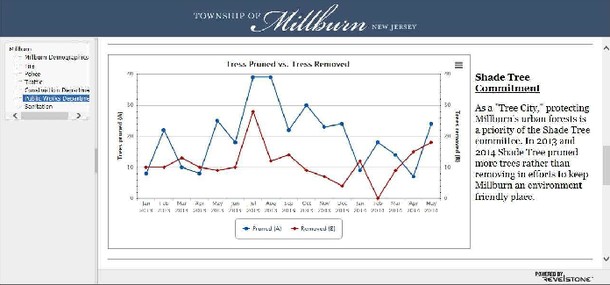Parsippany Startup’s Dashboard Helps Franklin Lakes, Millburn and Princeton Be More Transparent to Citizens

Parsippany startup Revelstone has introduced a citizen-facing product — the Public Performance Dashboard — for municipalities that are measuring the impact of their services using the company’s platform.
The company’s first product, Compass, is a cloud-based platform designed for local governments that combines performance analytics and benchmarking.
The Public Performance Dashboard is an easy way for citizens to see how various municipal services are being implemented.
Princeton is the most recent municipality to offer the dashboard on its website.
“Residents are starting to discover the citizen dashboard on our website,” Mayor Liz Lempert told NJTechWeekly.com.
“One of our goals is to increase the transparency of what we do, and often that means putting information in a format that is easy to read and understand,” Lempert noted. “The dashboard is an example of that. We’ve started with three departments: recreation, police, and public health. You can view data trends in graphic form, such as the number of monthly rabies cases or total pool visits each season.”
Lempert said that Princeton will continue to take advantage of “advances in technology that can help us do a better job communicating with residents and providing excellent service.” The town has recently launched another initiative, “Access Princeton,” a one-stop service center for citizens. They can call, email or use a free mobile app to report any municipal problem (pothole, downed tree, missed trash pickup, etc.) or to make an inquiry, according to Lempert.
The first town to incorporate the Revelstone dashboard on its website was the Borough of Franklin Lakes, which implemented it in June. The dashboard displays data about the Franklin Lakes construction and police departments and about the municipal court.
For example, users can see the number of construction permits issued, permit fees collected, and inspections completed. Revelstone says these are all indicators of the economic health and quality of life in the borough.
The dashboard also offers a historical perspective, as administrators and the public will be able to see trends in the performance of various departments over time. For example, a glance at the Franklin Lakes police department dashboard shows a downward trend in total crimes from 2008 to 2013.
Greg Hart, borough administrator of Franklin Lakes, said that the Revelstone platform allows communities “to easily publish information on how and what our departments are doing.” He added, “Making this information publicly available goes a long way towards helping our citizens understand how we manage the Borough and how we provide services.”
On August 1, 2014, the Township of Millburn became the second New Jersey municipality to post the dashboard on its website. Citizens can see key performance metrics concerning municipal services such as the police, fire department, construction and public works.
Alex McDonald, assistant business manager of Millburn, said, “Most citizens don’t know what is being done by the various township departments. They know their trash gets picked up, but now they can see all the other things that are being done with their tax dollars. It’s our way to help educate and be more transparent to our citizens.”
A look at the dashboard for sanitation shows that Millburn exceeded its goals for recycling in every month but February 2013, perhaps as a result of bad weather conditions. Millburn’s police department dashboard states that “despite the recent public perception that there has been an increase in crime, this data supports that there has actually been a significant decrease over the past few years.”
“Each municipality can put online what they think is of value to their community,” Mark Nelson, cofounder and COO of Revelstone, told NJTechWeekly.com. In fact, many of the municipalities will be adding more dashboards to their websites as time goes on.
Often the dashboards are accompanied by some interpretive language, noting, for example, that traffic stops went up because of a purposeful increase in enforcement activity. “What we ultimately want to get to are outcomes,” Nelson said. He added that communities want to know how their services impact the quality of life or make a municipality safer.
“This is really uncharted territory for municipalities,” Nelson noted. “They are new to being more open and transparent with their data … Even for a municipality to be analyzing data to see what’s happening in their own back yard is relatively new. Each of these communities started using our performance management program a couple of years ago. Now we’ve added some capabilities so they can be transparent to their citizens.”
The ultimate goal is to help citizens understand what happens with their tax dollars, Nelson continued. “We as citizens have a limited understanding of what is getting done with our tax dollars. This is a way for a city to start to show the value of the work that is being done in terms of how many inspections are being done or how many were done. We’ll potentially be able to look to see if increased traffic stops have any relationship to a reduction in accidents, for example.”

